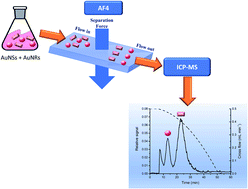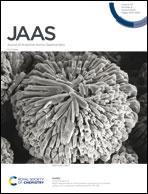AF4-ICP-MS as a powerful tool for the separation of gold nanorods and nanospheres†
Abstract
An analytical methodology based on asymmetric flow field flow fractionation (AF4) hyphenated to inductively coupled plasma mass spectrometry (ICP-MS) has been developed to separate gold nanorods (AuNRs) and nanospheres (AuNSs). This separation is of special interest because the latter are the main impurity in the synthesis of AuNRs by seeding growth procedures, and quality control tools are highly demanded. AF4-ICP-MS separation was performed using a regenerated cellulose membrane (molecular weight cut-off, MWCO, of 10 kDa), a 350 μm thick spacer and a phosphate buffer (1 mM NaH2PO4, 1 mM Na2HPO4 at pH 7) with 0.01% SDS as carrier. Several experimental parameters, such as focusing conditions and elution cross flow, and the injection/focusing time were optimized. Working under the optimum separation conditions, an adequate resolution was achieved between the void peak, commercially available AuNSs and AuNRs. The optimized method was successfully applied to the analysis of the products obtained in the synthesis procedure for AuNRs of 4.6 aspect ratio. Absorption molecular spectroscopy and transmission electron microscopy (TEM) have been used as complementary techniques.



 Please wait while we load your content...
Please wait while we load your content...